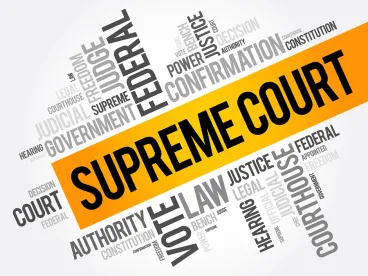Some call it the patent death squad. Others laud it as a powerful weapon in the battle against patent trolls. Whatever one’s opinion on the matter, the Supreme Court yesterday found that the U.S. Patent Office’s inter partes review (“IPR”) proceeding, a process that can invalidate patents many years after they issue, does not violate Article III of the Constitution.
The case was brought to the Supreme Court by Oil States Energy Services, LLC, an oilfield services company. Oil States argued that the Patent Office, an institution of the executive branch of the government, should not be deciding disputes on whether an issued patent should be invalidated, as this power is vested exclusively in the judicial branch of the government by Article III. In other words, the independent federal courts should be handling these patent validity disputes, not the Patent Office that issued the patent.
The dispute arose after the Patent Office invalidated two of Oil States’ patent claims, in a patent relating to an apparatus for protecting well head equipment. The IPR process that canceled the claims took place well over 10 years after Oil States had obtained its patent. The IPR process itself was established by the Leahy-Smith America Invents Act of 2011. The process allows the Patent Office to reconsider and cancel a patent owner’s issued patent claims based on prior art patents or printed publications, upon a petition by anyone that is not the patent owner. The IPR process takes place within the executive branch, before a panel of administrative law judges selected by the Patent Office’s director. In the case at hand, the IPR at the Patent Office was brought by Greene’s Energy Group, LLC, another company in the oilfield services industry, after Oil States sued Greene’s Energy for patent infringement in federal court.
The question at the Supreme Court became one of whether the IPR process is an exercise of the judicial power of the United States. This is because Article III of the Constitution vests the judicial power of the United States in the judicial branch of government (the so-called Article III federal courts), and so if the process is an exercise of the judicial power, IPRs cannot be decided by the executive branch’s Patent Office judges. The question of whether the IPR process is an exercise of the judicial power in turn hinged on whether the grant of patent is an exercise of public rights or private rights; this is because historically, Congress has had the authority to assign adjudication of public rights to non-Article III courts.
The 7-2 majority, in an opinion written by Justice Thomas, found that IPRs fall, “squarely within the public-rights doctrine” because they are merely the “reconsideration of the Government’s decision to grant a public franchise.” According to the opinion, “[i]nter partes review is simply a reconsideration of [the patent grant], and Congress has permissibly reserved the PTO’s authority to conduct that reconsideration,” and “[t]hus, the PTO can do so without violating Article III.” In other words, because Congress authorized the executive branch to grant patents, they can authorize the executive branch to reconsider that grant, as they have done with the IPR process.
As added support for its reasoning, the majority opinion noted that at the time of the framing of the Constitution, under English law, on which the American legal system is based, patents could be invalidated not only by the judicial system, but also by the Privy Council in England, a body akin to the U.S. executive branch judges today, in that it consisted of advisers to the monarch.
The spirited dissenting opinion, written by Justice Gorsuch and joined by Chief Justice Roberts, cites to a number of constitutional and historic papers to argue that patent rights are personal and private rights, “no less than a home or farm . . .” According to the dissent, a patent affords an inventor the exclusive rights to the fruits of her hard labor for two decades, after “much hard work and no little investment [into] devisi[ing] something . . . truly novel.” As such, when an IPR petition is filed against a patent, a political appointee at the Patent Office should not be able to resolve the IPR and revoke these hard-earned private rights; rather, an independent judge from the Article III judicial branch should be the one to do so. Justice Gorsuch’s opinion ends with a passionate paragraph explaining his reasoning:
But enforcing Article III isn’t about protecting judicial authority for its own sake. It’s about ensuring the people today and tomorrow enjoy no fewer rights against governmental intrusion than those who came before. And the loss of the right to an independent judge is never a small thing. It’s for that reason Hamilton warned the judiciary to take “all possible care . . . to defend itself against” intrusions by the other branches. The Federalist No. 78, at 466. It’s for that reason I respectfully dissent.
(Dissent at 12.)
The practical implication of the Supreme Court’s decision is that the IPR process will remain in place at the Patent Office. Change may still be coming, however, as the new Patent Office director, Andrei Iancu, has made waves recently in public speeches and testimony to Congress, pointing out some of the perceived problems with the patent system as a whole, and with certain IPR procedures in particular, the implication being that there are solutions coming down the pipeline.
The case is Oil States Energy Services, LLC v. Greene’s Energy Group, LLC (No. 16-712) in the United States Supreme Court. A copy of the slip opinion is attached here.



 />i
/>i
